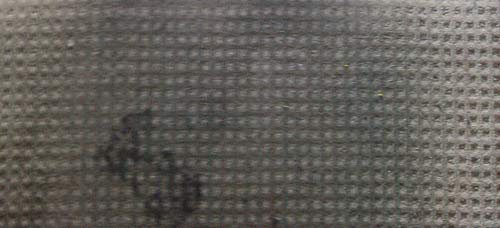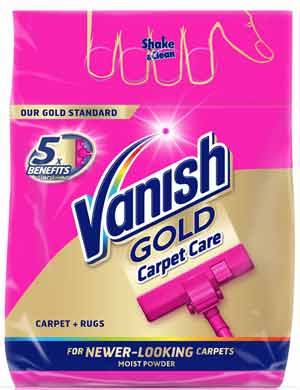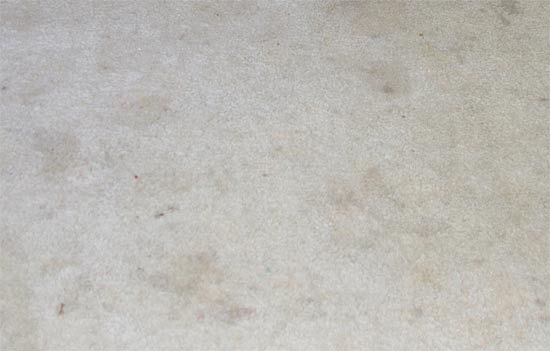If you’ve ever had new carpets and underlay installed, you know the transformative effect they have on a room—adding comfort and elegance. However, over time, especially in high-traffic areas, carpets can lose their freshness. The underlay compresses, and the carpet piles flatten, making the carpet look worn.
But don’t worry, there’s hope! You can rejuvenate your carpets with a thorough cleaning to remove ground-in dirt, grime, and stains. In this guide, we’ll explore effective carpet cleaning methods and tools.

Badly stained and flattened section of carpet
Routine and Deep Carpet Cleaning Methods
Maintaining clean and well-kept carpets involves regular upkeep alongside occasional deep cleaning sessions.
Regular Carpet Maintenance Tips
Vacuum your carpets weekly to keep them clean and prevent wear from foot traffic. Ensure thorough vacuuming to lift compacted piles and maintain freshness.
Move furniture when vacuuming to reach hidden carpet areas, eliminating dust, mites, and grime that accumulate underneath.
Consider using powder or shampoo carpet cleaners, available at supermarkets, to enhance cleaning effectiveness before vacuuming.

Vacuuming a carpet regularly keeps it clean – Image courtesy of moderncastle.com
Periodic Deep Cleaning
In addition to regular vacuuming or shampoo cleaning, periodic deep cleaning is beneficial for carpets. Here are your options:
- Domestic carpet cleaner purchase or hire
- Professional carpet cleaning service
Domestic carpet cleaners, resembling upright vacuums with water tanks, are available for purchase at reasonable prices, typically around £150 to £200. These machines use water and rotating brushes to scrub and lift dirt, providing effective cleaning.
If purchasing isn’t an option, consider renting a professional-grade machine from local hire shops or supermarkets. RugDoctor machines are commonly available and offer professional results when used correctly.
Alternatively, opt for a professional carpet cleaning service, commonly using Hot Water Extraction (HWE) or Dry-Cleaning Very Low Moisture (VLM) systems. While each has its pros and cons, reputable companies ensure well-cleaned carpets. Find trusted professionals in your area through our find a tradesman service.
In the next section, we will look at the different cleaning powders, shampoos, and carpet cleaners on offer.

Deep cleaning a carpet using a professional carpet cleaner
Types of Carpet Cleaning Methods
There are essentially five primary carpet cleaning methods available today. Whether you’re tackling it yourself or hiring professionals, the method employed will typically fall into one of the following categories:
Hot Water Extraction Carpet Cleaning (HWE)
Hot Water Extraction (HWE), similar to steam cleaning, starts by applying a cleaning detergent to the carpet surface, allowing it to penetrate and loosen dirt.
Then, a rotating brush on the cleaner agitates the carpet fibres while hot water is injected under high pressure, lifting dirt and grime.
After cleaning, the carpet typically needs overnight drying time.

Hot water extraction carpet cleaning
Shampoo Carpet Cleaning
Shampoo carpet cleaning, once popular until the 1970s, involves applying a shampoo detergent diluted with water onto the carpet.
After letting it sit for a few minutes to tackle grime, you scrub it with a stiff brush before letting it dry.
Once dried, the carpet is vacuumed to remove lifted dirt. However, this method often leaves a sticky residue, attracting more dirt and making the carpet dirtier over time.

Cleaning a carpet using shampoo
Encapsulation Carpet Cleaning
Encapsulation carpet cleaning, a form of dry cleaning, applies a synthetic detergent that crystallises into powder when dry.
This powder lifts dirt from the carpet’s surface, trapping it within the crystallised particles. Once dry, the powder residue is vacuumed away.
Preferred by those with environmental concerns due to its reduced chemical usage and minimal residue, encapsulation cleaning works well on moderately dirty carpets but may struggle with heavily soiled surfaces.

Encapsulation cleaning a carpet
Bonnet Carpet Cleaning
Bonnet carpet cleaning offers a rapid solution for high-traffic areas like offices that need quick drying. It’s more of a “quick fix”.
A machine with rotating pads soaked in detergent swiftly cleans the surface, but it may not effectively remove deep-seated dirt and can push some debris back into the carpet.

Cleaning a carpet using a bonnet cleaner
Dry Cleaning Carpets
Dry cleaning, a method developed in the mid-1980s, offers various options, including encapsulation cleaning, dry compound, and dry ice.
In this process, a cleaning compound is applied to the carpet’s surface, brushed into the pile, or pushed in with a machine. The compound absorbs dirt and grime, which is then vacuumed up.
Results are generally effective, with minimal drying time due to the absence of water. Always check with the carpet manufacturer for recommended cleaning methods and test on a small area first.

Dry cleaning a carpet – Image courtesy of diynetwork.com
How to Clean Your Carpets
Now that we’ve explored cleaning methods, products, and equipment, let’s dive into the process of actually cleaning your carpets.
For this guide, we’ll focus on the most accessible methods and discuss their benefits to help you choose the right one for your needs.
Before you begin cleaning, there are a few preparatory steps:
- Remove furniture from the room or shift it to the centre to clean around it.
- Vacuum the entire area to eliminate initial dirt and dust.
- Treat heavily stained areas with a pre-cleaning product.

Room totally emptied ready for carpet cleaning
Using Powder Carpet Cleaner
To clean your carpets with powder cleaner, follow these steps:
Start by checking the manufacturer’s guidelines on the packaging for any specific instructions. Typically:
- Evenly scatter the powder over your carpet surface.
- Allow the powder to sit for at least 30 minutes, preferably longer.
- Vacuum up all the powder after the specified time.
- If stains persist, repeat the process, leaving the powder on for a longer duration.
Powder cleaners are popular for their simplicity and quick results, as they require no drying time. However, the convenience can lead to rushing, potentially reducing effectiveness if not left for the recommended duration.

Vanish carpet cleaning powder yields good cleaning results
Using Shampoo Carpet Cleaner
There’s a wide array of carpet shampoos available today, all serving the same basic purpose despite slight variations among manufacturers.
Before application, always refer to the manufacturer’s guidelines for specific usage instructions. Here’s a general approach:
- Some shampoos are ready-to-use, while others require dilution according to the manufacturer’s instructions.
- Apply the shampoo evenly across the carpet surface, avoiding over-saturation of any area.
- For stubborn stains, gently scrub with a stiff brush, being careful not to damage the carpet pile.
- Allow the carpet to fully dry after cleaning.
- Once dry, thoroughly vacuum the area to remove any remaining shampoo residue.

Using a carpet shampoo cleaning machine to clean a carpet – Image courtesy oof angloclean.co.uk
Carpet Washers – The Upright Vacuum Type
Upright carpet washers, also known as wet/dry vacuums, offer an effective way to maintain clean and fresh carpets at home.
These machines work by dispensing a blend of water and cleaning solution, penetrating deep into the fibres to eliminate various forms of dirt and grease, and then extracting the dirty water.
Removing greasy dirt is crucial for restoring the appearance of your carpet, making it look newer and more vibrant. Additionally, carpet washers help eliminate odours, pollen, and germs.
While there’s a wide range of upright carpet cleaners available from major vacuum manufacturers, they typically operate similarly. Always refer to the manufacturer’s instructions for specific usage guidelines for a particular machine.
Most manufacturers recommend using their own brand of detergents to avoid potential damage or warranty issues. Following these guidelines ensures optimal performance and longevity of the machine.
- Prior to cleaning, plan your route to avoid redundancy and over-saturation of areas.
- Fill the clean water tank to the specified level with either hot or cold water, depending on the manufacturer’s instructions.
- If applicable, fill the detergent container to the specified level with the recommended detergent.
- Plug the machine into a power outlet.
- Turn on the cleaner and tilt the handle backward into the cleaning position.
- Depress the detergent/solution trigger to release the cleaning solution onto the carpet.
- While pulling the trigger, move the cleaner backward to evenly distribute the solution over the carpet.
- Once the solution is applied, move the cleaner forward to allow the brushes to scrub the carpet and remove the dirty water.
- Some machines feature a manual scrubbing mechanism; follow the manufacturer’s instructions for operation.
- Monitor the dirty water tank to know when it’s nearly full, then turn off the machine, empty the tank, and continue cleaning if needed.
- After cleaning, rinse out any tanks and filters with warm water and allow them to dry completely before storage.

Bissell upright carpet cleaner
Using a Specialist Hired Carpet Cleaner
These machines are often heavy-duty, typically rented from a hire shop or used by specialist cleaning companies when hired to clean a certain area.
If you opt for a DIY approach, you’ll likely encounter the RugDoctor machine, which offers results akin to professional steam cleaners but on a domestic scale.
Operating similarly to a steam cleaner, these units force hot water and chemicals into the carpet, dislodging stubborn dirt and killing bacteria and dust mites.
Here’s a simplified guide for using a RugDoctor:
- Remove the recovery tank to access the base tank.
- Fill a bucket with nine litres of warm water (not scalding hot).
- Add 150ml of RugDoctor detergent (or 225ml for wide track machines) to the base tank and top up with hot water.
- Replace the recovery tank securely.
- Switch on the machine and adjust the handle for comfort.
- Turn on the vacuum and spray functions.
- Start cleaning by walking backward, pressing the spray button as you go.
- Release the spray button at the end of each pass to avoid excess water and detergent.
- Overlap each pass slightly to ensure full coverage.
- Monitor and empty the recovery tank as needed.
- Repeat until the entire carpet is cleaned.
- Once finished, ventilate the room for drying.
- Thoroughly clean the machine before returning it.
For detailed instructions and tips, consult the manufacturer’s website. Always follow the manufacturer’s guidelines for optimal usage.

Cleaning carpets uisng a RugDoctor cleaner
Hiring Professional Carpet Cleaners
If the thought of cleaning your carpets yourself doesn’t appeal to you, consider hiring professionals.
Most towns and cities have local carpet cleaning businesses. It’s wise to gather 2 or 3 quotes to compare.
When companies come to quote, ask for references from past customers to assess their service quality and business practices.
While cost is important, don’t automatically opt for the cheapest option as quality may suffer.
Save yourself the effort and let professionals handle it. Find reputable carpet cleaners near you through our service.
Dealing with Carpet Spills and Stains
Regular cleaning and occasional deep cleaning maintain your carpet’s condition, but what about spills and little accidents?
The key to success here is to act fast to minimise any damage:
- For liquid spills, blot with clean paper towels without rubbing to prevent pushing into the carpet.
- For semi-solid spills, gently scoop up excess, then rinse with water and blot dry.
- Avoid scrubbing, as it can damage the carpet, spread the stain or push it further into the pile.
- If needed, use an off the shelf spot cleaner or one of the many homemade solutions detailed online.
Many stain removers are available, each suited to different types of stains. Explore homemade cleaner options online, such as this one here.

Stains and markes on light coloured carpet
Spot Cleaning Carpets
To tackle spots or stains on your carpet, even old ones, a spot cleaner can help.
Choose a cleaner suited to your carpet and the type of stain. Test it on a small area first to avoid damage.
Apply the cleaner to a clean cloth and gently work it into the spot, starting from the outside. Let it sit for a few minutes, then blot with a clean cloth.
Repeat until the stain is gone, then rinse with cold water and blot dry.
If needed and the stain won’t budge, it’s worth trying a different cleaner for stubborn stains, some work better than others on particular types of stain.

Spot cleaning a carpet using a liquid shampoo carpet cleaner
Preventing Carpet Stains and Damage
Prevention is key to keeping your carpets clean. Asking people to remove their shoes indoors can significantly reduce dirt and stains. Shoes track in dirt and grime, which can embed deep into the carpet fibres.
If removing shoes isn’t feasible, provide doormats for wiping feet before entering. This helps minimise dirt transfer.
Consider treating new carpets with a stain-guard to make spills easier to clean. This prevents liquids from seeping into the carpet fibres.
Before using any cleaning products or machinery on your carpets, check with the manufacturer for recommended methods. Woollen carpets, especially delicate ones, require special care and can be damaged by certain cleaning methods.
If you have carpets in your home, to reduce marks, staining and general dirt and grime buildup it is essential that you maintain them and keep them in as good a condition as possible, through routine maintenance such as vacuuming and also periodic deep cleans.

